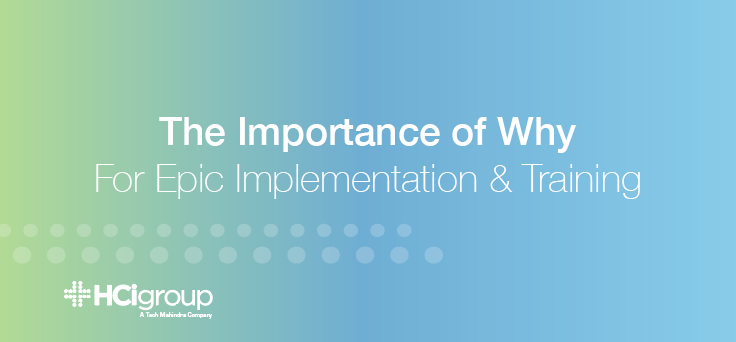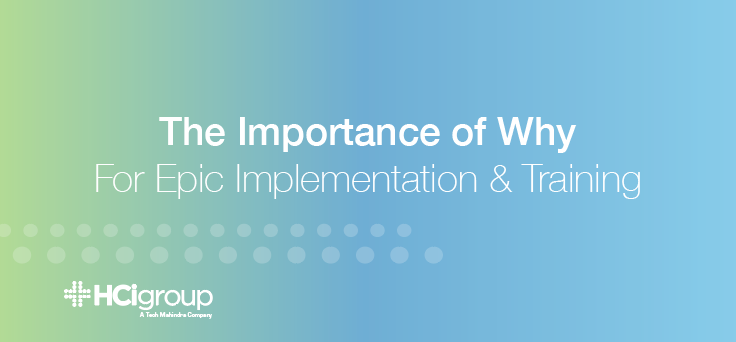The Importance Of Why For Epic Implementation and Training


Implementing an Epic EMR system for a hospital network is a big deal. There is a lot of cost and effort associated with an EMR implementation of this scale, and it must be well planned to avoid on-going spend and continued disruption to the organization. As Epic Implementation experts, we know that zero disruption is impossible. But setting the right expectations and deliverables on a reasonable, well-socialized schedule allows for minimal downtime and fewer disgruntled end users. (Fewer. Not zero.) One of the important conversations we encourage in Phase 1 of Epic Training is Why, as the absence of this understanding will hinder your progress every step of the way.
More and more companies are being encouraged to consider “their Why.” This amounts to everything from motivation to do business, core purpose of products created/services offered, and contributes heavily to company culture and organizational priorities. Contemplating such things may seem a little woo-woo and startup-y for the care-focused health systems we serve, but this step is nevertheless key in helping to define scope and execute against agreed-upon goals for making any kind of change to a large, multi-faceted organization. It is no small task to implement a new EMR systems -- or any system, for that matter -- across the complex network of users unique to hospitals and care networks. Pausing to establish the why of the project is critical for moving each step ahead with true buy-in and ample appreciation for the necessity of the work to be done.

When Unrecognized Stakeholders Create Roadblocks To Implementation
The most surefire way to realize who is unrecognized as vital to a project is to leave them out of the planning phase, only to stumble across them later in all their fury and frustration.
For example, if your Epic Training plan places heavy reliance on designated Super Users to help roll out and encourage forward momentum of user adoption and workflow refinement, you’d better make sure they:
- Know that they’ve been designated as such, and
- Are clear on the requirements of that role as it pertains to project completion
We’ve seen it happen over and over again -- despite persistent counsel to avoid it -- where clients incorporate later-than-is-prudent key resources into the project planning. At this point, they’ve missed the “why” conversation and have very little connection to the purpose of the heavy lifting they’re being asked to do. These feet-on-the-ground roles are absolutely vital to the success of an implementation project for healthcare systems, and they’re often the very ones who are not given the appropriate motivation or big picture pursuit.
Resource Constraints Will Sideline Your Training Plan Like No Other
When the relevant motives are not disseminated to all involved parties, what tends to happen is unanticipated resource constraints. Key players are plugged into a tight schedule, and when the time arrives to engage them for action (just in time), they’re unknowingly tied up with other projects, or sometimes simply on vacation during the anticipated period. With a well-understood and respected driving force for the Epic implementation -- including a firm grasp of the true value-add -- resources are far more likely to prioritize (or have prioritized on their behalf) their availability and willingness. The latter is as important, if not more so, than the former for ensuring solid adoption and facilitating a well orchestrated Epic Go-Live.
There’s Room For Everyone At The Planning Table
You can’t please everyone, and we know that’s true on any given project, no matter the size. Especially given the sheer complexity of an Epic Implementation for health systems, it’s important to stay focused and decisive in all phases of deployment. However, we believe that it’s wise to let representative stakeholders at all levels attend planning meetings to better grasp the big picture and overall why of the project. It’s not uncommon for end users to have very little (if any) “voice” from the inception, and yet the success of the implementation depends on those end users thriving with the new technology and workflows for the overall benefit.

It’s obvious that you can’t invite every end user to implementation kick-off meetings. But it is nevertheless a smart move to include someone who can represent that perspective to better account for concerns and points of contention. Proactively managing and anticipating headaches sets organizations (and their IT partners) up for success in rolling out new interfaces and tools that are ultimately designed to improve the user experience, whether directly or indirectly. Speaking to that from the get-go in an informed, considerate way is often the key to paving a path for buy-in and attentiveness that will resist barriers on the road to Epic adoption.
